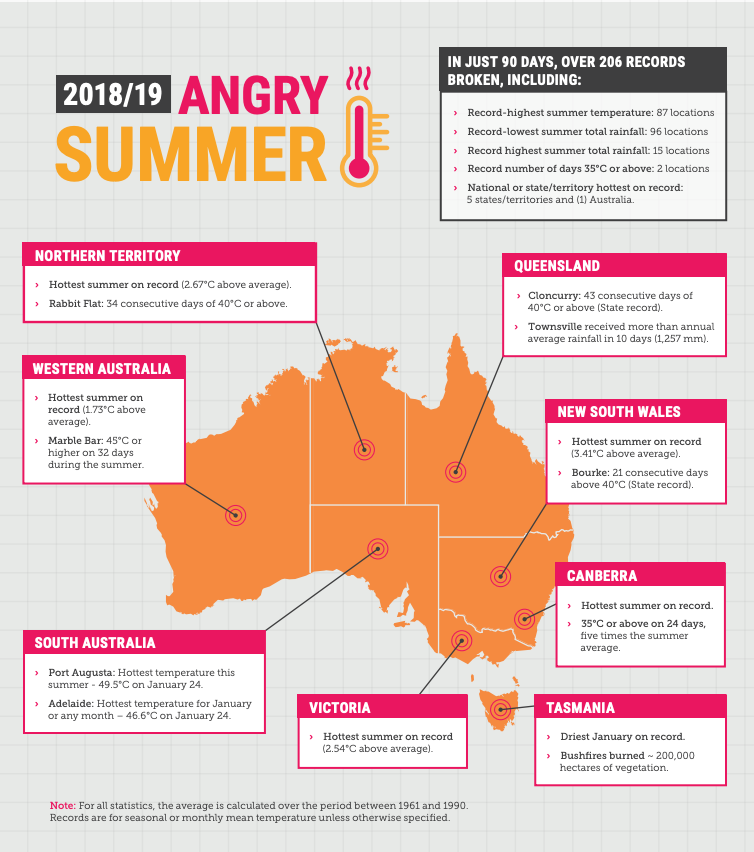'Unprecedented': Sydney and Melbourne could be set for 50C days
Melbourne and Sydney could experience frequent 50 degree Celsius summer days by the end of the century if greenhouse gas emissions continue rising at their current rate, a climate report has suggested.
The Climate Council’s latest report, Dangerous Summer: Escalating Bushfire, Heat and Drought Risk, said the burning of coal, oil and gas had “supercharged” extreme weather events.
This had put increasing strain on the Australian economy, the environment and human lives, the report said, highlighting the necessity of immediate change.
“If greenhouse gas emissions continue to rise, the unusually hot weather currently experienced will become commonplace, occurring every summer across the country,” the report stated.
“Sydney and Melbourne could experience unprecedented 50C summer days by the end of the century.”

Australian temperature records during 2018-19
More than 206 weather records were broken in just 90 days across the country last summer, including five states/territories recording their hottest summers ever recorded.
Bourke in rural NSW had 21 consecutive days above 40 degrees, in Canberra it was 35 or above on 24 days - five times the summer average - and Adelaide recorded its hottest temperature, 46.6.
Marble Bar in Western Australia recorded 45 degrees or higher on 32 days during the summer, Rabbit Flat in the Northern Territory had 34 consecutive days of 40 or above, and about 200,000 hectares of vegetation was burned in Tasmania.

Meanwhile in Queensland, Cloncurry had 43 consecutive days of 40 or above, and Townsville received more than its annual average rainfall in just 10 days.
More extreme weather for Australia
On a meta scale, the report predicted that climate change would cause more intense but less frequent cyclones, more intense extreme rainfall events, harsher bushfire weather, and longer and hotter heatwaves.
Potential severe thunderstorm days were also expected to increase, higher sea levels would increase flooding in coastal cities and towns and droughts were likely to happen even more often.
Head of Research at the Climate Council, Dr Martin Rice, said increasing global gas emissions was posing an immediate and ongoing threat to the well-being of both humans and animals.

“Since November, we’ve had a loss of six lives in NSW and hundreds of properties NSW and QLD, these conditions are being made worse by climate change,” Dr Rice told Yahoo News Australia.
“The toxic air quality from bushfire smoke saw 60 people admitted in early November because of toxic bushfire smoke.”
He said the toxicity of air in some parts of Greater Sydney was equivalent to smoking 40 cigarettes a day.
People can combat climate change by changing habits
Dr Rice said Australia was well-placed to take action against the climate emergency, but people needed to not only demand action from political leaders, but also work on changing their own daily habits.
“Australians need to demand action on climate change. The government’s reaction so far has been hollow at best, and what we’re seeing now are the devastating affects of its inaction,” he said.
“We all have an opportunity to contribute, we need to think about how we power our homes, we can think about our elected leaders, how we finance and our bank, especially their relationship with fossil fuels.
He suggested people reduce their meat consumption and eat more vegetables, and consider using active or public transport to get around, as opposed to car travel.
The report said prolonged drought across eastern Australia was threatening crops for a third year in a row, with national summer crop production forecast to fall by 20 per cent to 2.1 million tonnes in 2019/20.
It also said health impacts of bushfires were widespread, and included direct losses of life, physical injuries and mental health issues.
“Large populations are also at risk from the health impacts of bushfire smoke, which contains respiratory irritants and cancer causing substances,” the report said.
Do you have a story tip? Email: newsroomau@yahoonews.com.
You can also follow us on Facebook, Instagram and Twitter and download the Yahoo News app from the App Store or Google Play.



